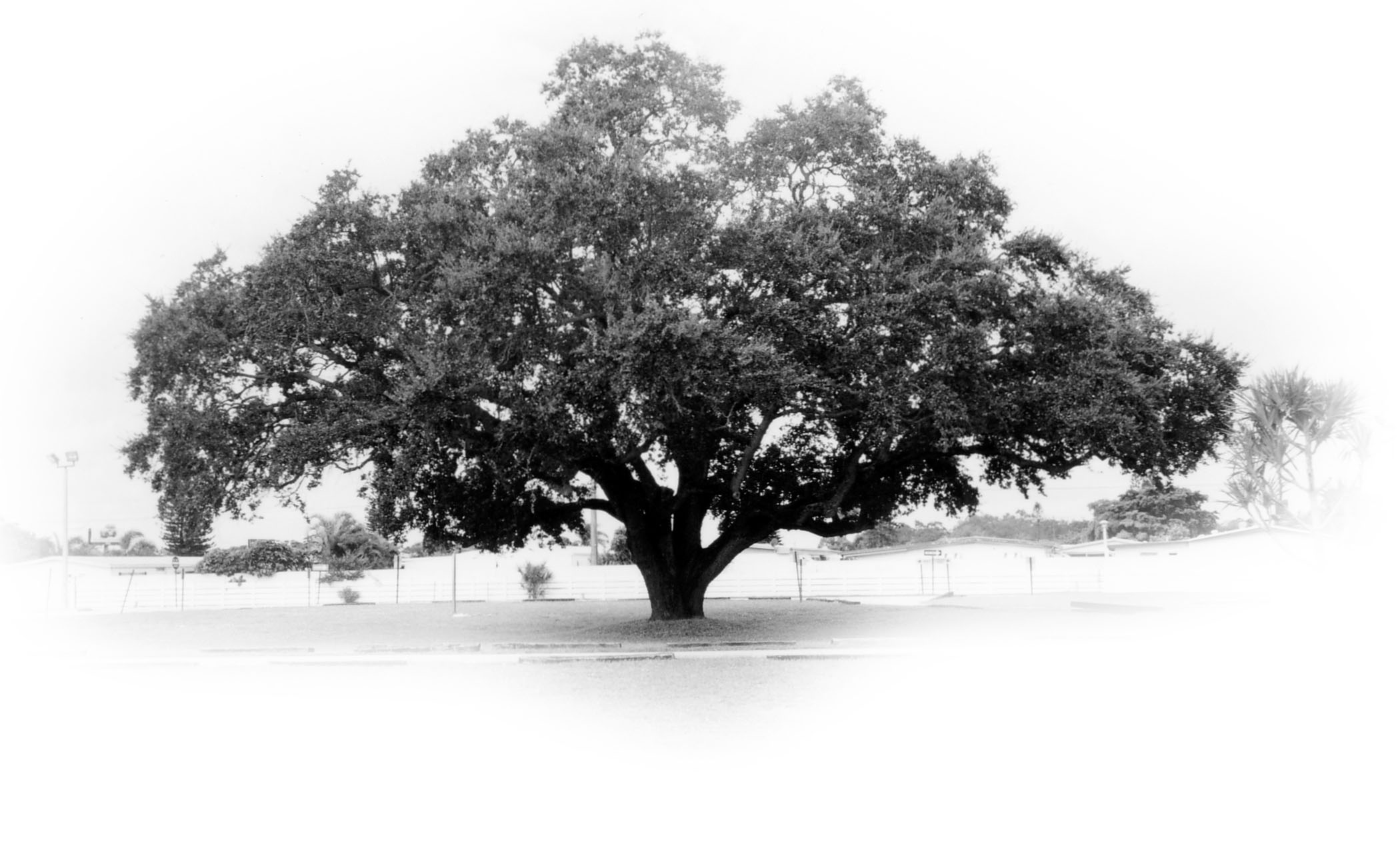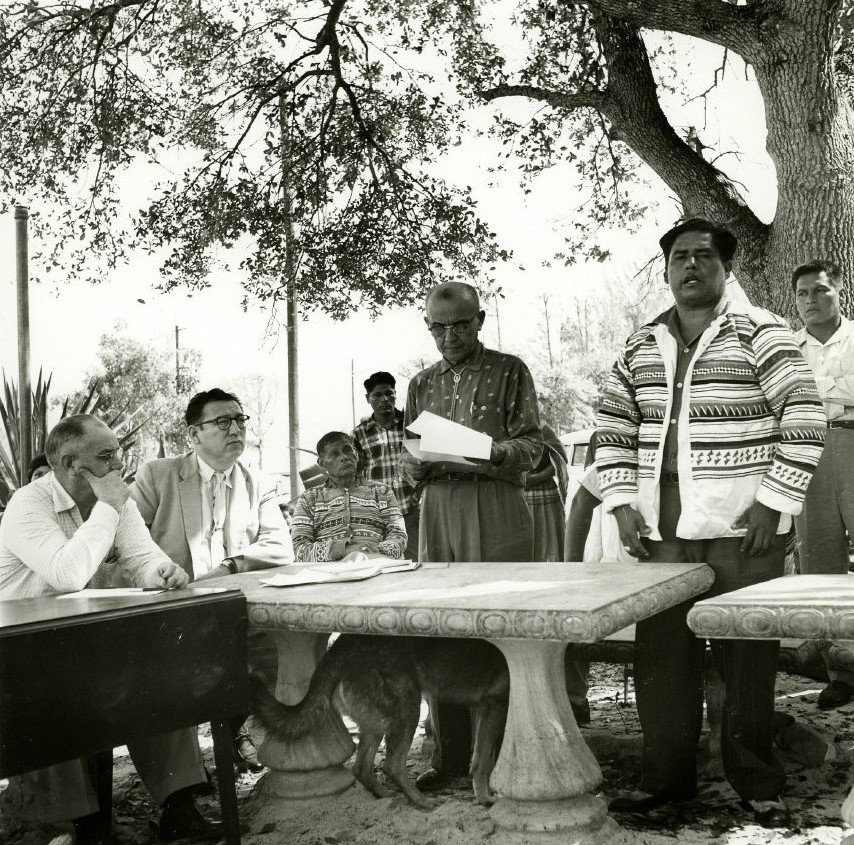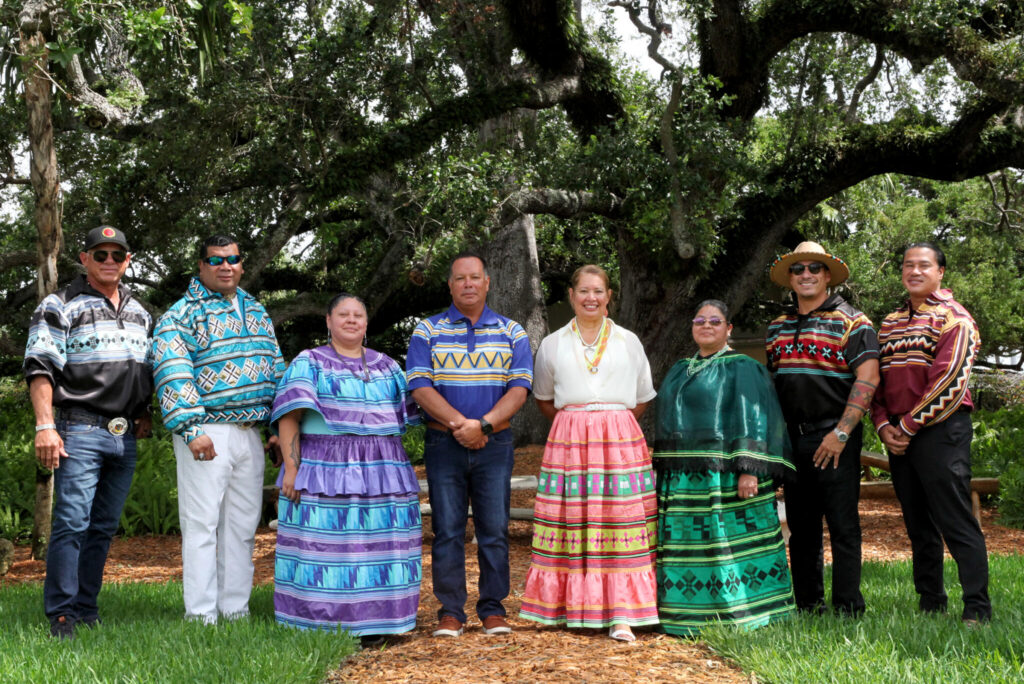
Beneath the Branches: Council Oak, Survival, and Indian Termination
August 21st Marks the 68th Anniversary of the federal recognition of the Seminole Tribe of Florida by the United States. This week, join us as we add another installment to our Seminole Spaces series. We are taking a look through the lofty branches of the Council Oak tree. Located on the Hollywood Reservation, this tree stood witness to the Seminole fight for federal recognition. But did you know its history goes back much further than that? Today, join us to take a closer look at this incredible tree, and just some of the ways it has been a witness to Seminole history for generations.
Big City Island Settlement
The Council Oak stood firmly rooted in Seminole history even before federal recognition. Around 1828 Seminoles would settle in the Hollywood/Dania area, establishing what was then known as Big City Island. If you recall from earlier blog posts, this time was one of incredible upheaval for the Seminoles of Florida.
Since the Spanish had ceded control to the United States, Seminoles had continuously been pushed further south into the Florida peninsula. Seminoles had also been melding with other tribes fleeing aggression and encroaching European settlement, such as the Creek. Upper Creek, who settled places like Chocochatti to the north, had fled as early as 1787. Others, fleeing the Creek Wars, would trickle down later and meld with the Seminoles of Florida.
The early 1800s were then a period of incredible upheaval for both Seminoles and other Indigenous peoples of the Southeast. Seminoles were being displaced from their homes in Florida and pushed down through mounting aggression and pressure both from the United States government and settlers coming into the area. Big City Island was established around 1828, and historians believe that the Council Oak was already standing during that time. Only two years later the Indian Removal Act of 1830 would ignite the powder keg. It would bring about the darkest times in history for the Indigenous people of the Southeast.
The Council Oak was part of the original Big City Island Settlement and was present before it was established in 1828. This is also long before Hollywood ever existed, and almost 100 years before the Dania Reservation would be formally established in 1926.
Indian Termination Policies
There is a fallacy in the history books that after the end of Indian Removal there were no more concentrated efforts to undermine and eradicate Indigenous communities and cultures. Unfortunately, this is incredibly untrue. Post-removal, the United States continued to push several policies designed to cut Indigenous people off from their cultures and communities.
A stark example of some of these policies came about in the 1950s and 1960s. These are known as Indian Termination. The U.S. government aimed to end its trustee relationship with the tribes to fully assimilate them as ‘Americans.’ On the surface, this gave the impression that “Congress wished to free tribes from federal oversight.” However, the true intent was far more harmful. In practice, these policies served to control and erase Indigenous rights, culture, and traditions. Ultimately, they resulted in the government no longer recognizing a tribe’s sovereign rights.
Seminole leaders were incredibly aware of the threat to their sovereign rights and the eventual fallout from these Indian termination policies. In response to these policies, a “new generation of Seminole leaders began to meet regularly under the branches of an old oak tree on the Hollywood reservation during the 1950s.” It was this council that gave the old tree its name: The Council Oak.
Below, you can see the Tribe’s Constitution and Charter Committee meeting under the Council Oak in March of 1957. Only a few months later, on August 21, 1957 Tribal members would again gather to vote on the ratification of their constitution and corporate charter. From left to right: Unidentified, Res (Rex) Quinn, Josie Billie and Joe Bowers (in background), Kenneth A. Marmon, Billy Osceola, Jackie Willie.

2009.34.5803, ATTK Museum
Rex Quinn’s Oral History
Prior to receiving federal recognition, Seminoles would first have to demand it. In 1957 a group of Seminole leaders including Bill Osceola, Billy Osceola, Betty Mae Jumper and Laura Mae Osceola approached Glenn Emmons, Commissioner of Indian Affairs for the U.S. Department of the Interior. They wanted the Seminole people to have control over their own affairs and decisions. Emmons sent Sioux Indian Reginald “Rex” Quinn, from the Tribal government branch of the Bureau of Indian Affairs to look into their request. He also was present to help them draft their constitution and bylaws, necessary documents for self-governance.
A meeting with the Seminoles was held beneath the Council Oak Tree in 1957. Quinn would recount two decades later through the University of Florida’s Oral History Program:
“I got to the agency at 2 in the afternoon, and the Indians were there from all the reservations, and we met under the old oak tree. This was a very colorful meeting. The Seminoles were there in native dress. It was a natural meeting. There were no chairs or anything. There was a small table and a couple of chairs for me and the superintendent to sit on. The rest of them were either standing or sitting on the ground. Bill and Laura Mae and Billy got up, and they explained to the group what had transpired and that they were now in a position to go ahead with the process of setting up a Tribal government.
They asked me what they had to do. I told them that they were going to have to appoint a constitutional committee and that I would work with this constitutional committee to draft a constitution and a charter. When we got through with that, we would explain it to the people so they understood it. Then they would have a chance to vote on it. It was important to get good representation on this constitutional committee because these were the people who would be drawing up a document that was going to be a permanent part of their history.
After much discussion the general council selected a constitutional committee. Bill Osceola was made Chairman of that committee, Mike Osceola was made secretary of that committee [and] Laura Mae was designated as interpreter. Billy Osceola and John Henry Gopher from Brighton were on that committee. Frank Billie from Big Cypress and Jackie Willy from Dania made up [the rest of] that committee.”
National Register of Historic Places
Federal recognition as the Seminole Tribe of Florida was an incredible milestone for the Seminole people. This year marks the 68th anniversary of that milestone: one that paved the way for all the Seminole Tribe is today. The Council Oak stood witness to this incredible event, and many others in Seminole history.
It was because of that moment that the Seminole Tribe of Florida’s Tribal Historic Preservation Office (STOF-THPO) decided to nominate it for the National Register of Historic Places in 2012. This was based on its eligibility as “as a property associated with events that have made a significant contribution to the broad patterns of history.” The Council Oak was added to the National Register of Historic Places on December 2, 2012.
A Tree Stands Witness to History
The Council Oak continues to stand as a witness to Seminole history and the continued fight for tribal sovereignty. Even though the Seminole Tribe of Florida is federally recognized, it is incredibly important to protect these sovereign rights. The Seminole Tribe of Florida continues to do that on a daily basis, reinforcing their right to self-governance through their actions. The Council Oak also continues to witness many important moments in Seminole history and the Seminole story. Today, it is often still the site of many critical functions, such as inaugurations, signings, and other momentous events.
As with many other years, the Council Oak was the backdrop for the 2025 inauguration of the newly elected Tribal Council and Board of Directors on June 2, 2025. At the inauguration ceremony, Chairman Marcellus W. Osceola Jr. underscored the importance of these moments. He said to the audience “A wholehearted, heartfelt congratulations to our ancestors for the reason that we’re here. … That’s the strength and power that we have of survival to forge the future for our families. Congratulations to everyone in this room for keeping that alive.”

From left to right are Hollywood Councilman Chris Osceola, Brighton Councilman Larry Howard, Big Cypress Councilwoman Mariann Billie, Chairman Marcellus W. Osceola Jr., President Holly Tiger, Big Cypress Board Rep. Nadine Bowers, Brighton Board Rep. Bryan Arledge and Hollywood Board Rep. O’Hara Tommie. Photo by Beverly Bidney for the Seminole Tribune.
Author Bio
Originally from Washington state, Deanna Butler received her BA in Archaeological Sciences from the University of Washington in 2014. Deanna moved to Florida in 2016. Soon, she began working for the Seminole Tribe of Florida’s Tribal Historic Preservation Office. Deanna was the THPO’s Archaeological Collections Assistant from 2017-2021. While at the THPO, Deanna worked to preserve, support, and process the Tribe’s archaeological collection. She often wrote the popular Artifact of the Month series and worked on many community and educational outreach programs. Now, Deanna works for the Seminole Tribe of Florida’s Seminole Media Productions Department. She lives in Lakeland, FL with her husband, two sons and daughter, and dog.


